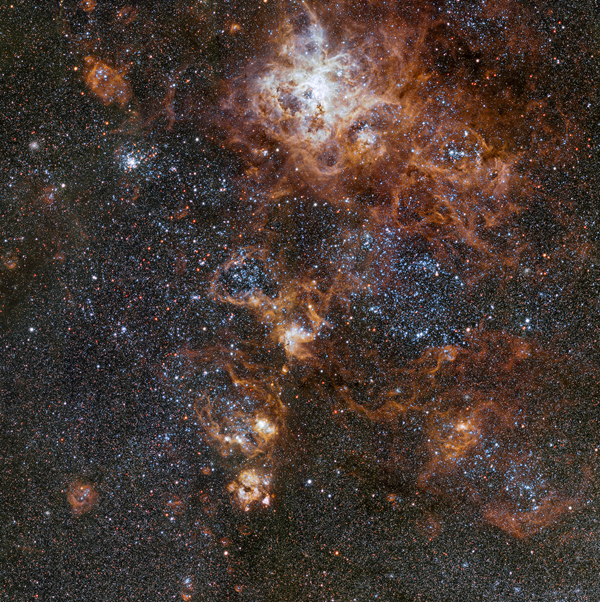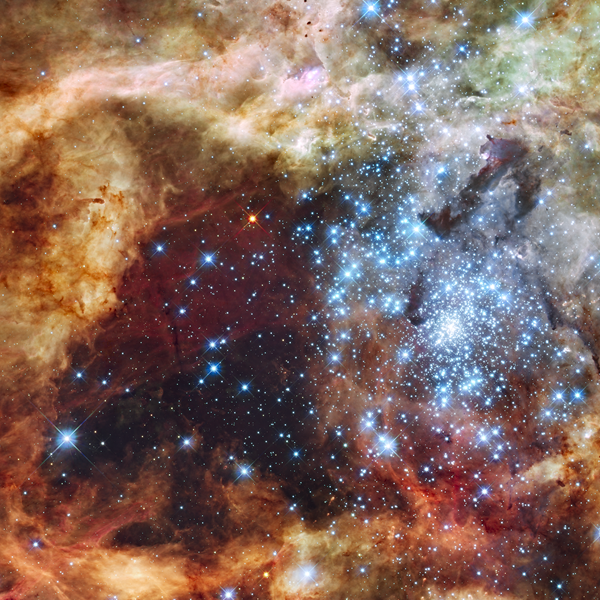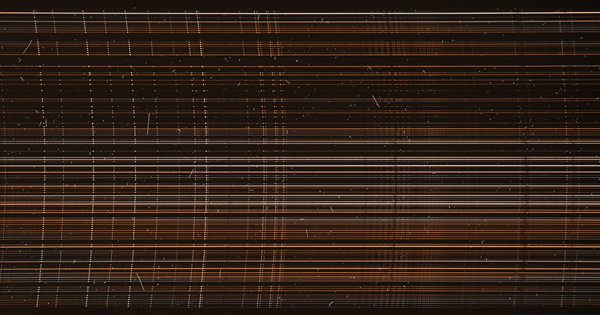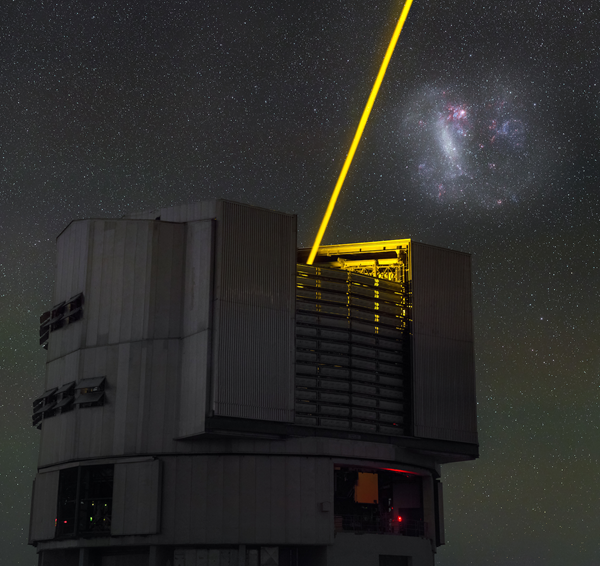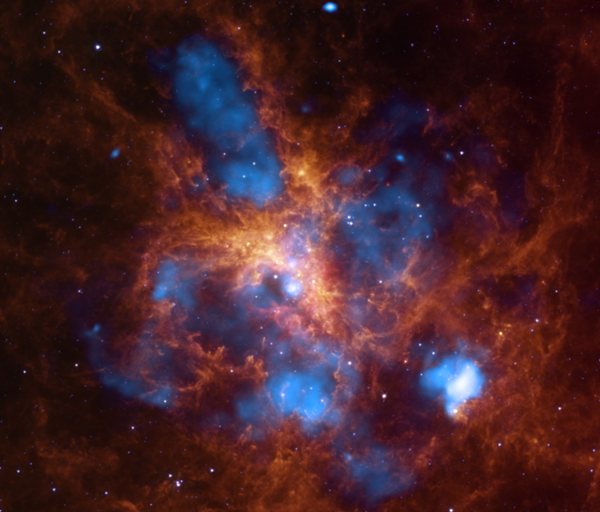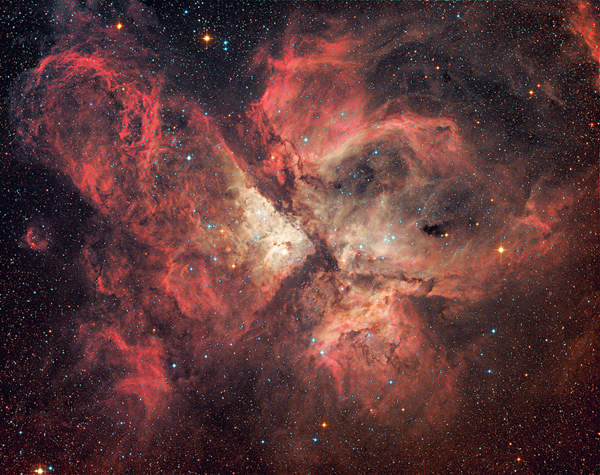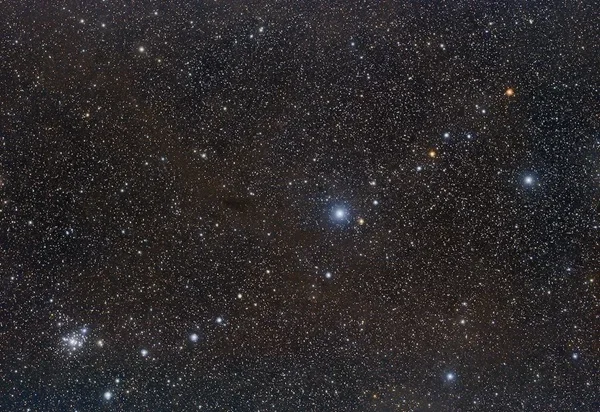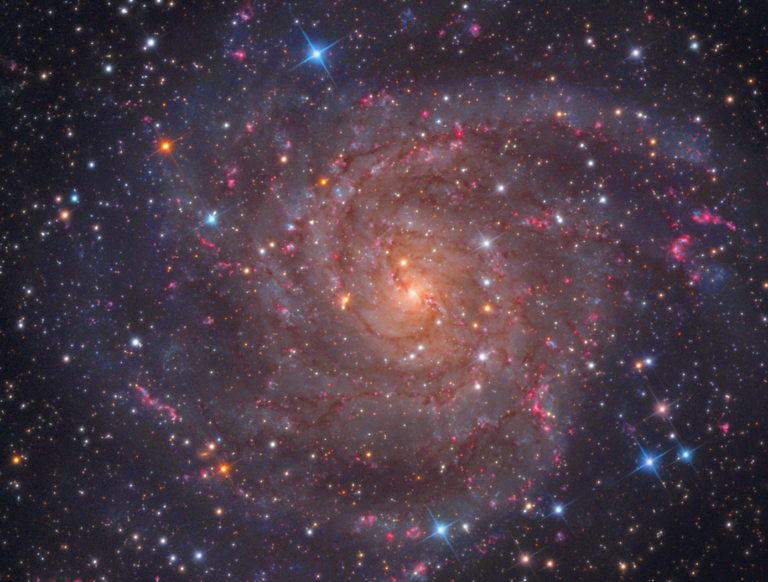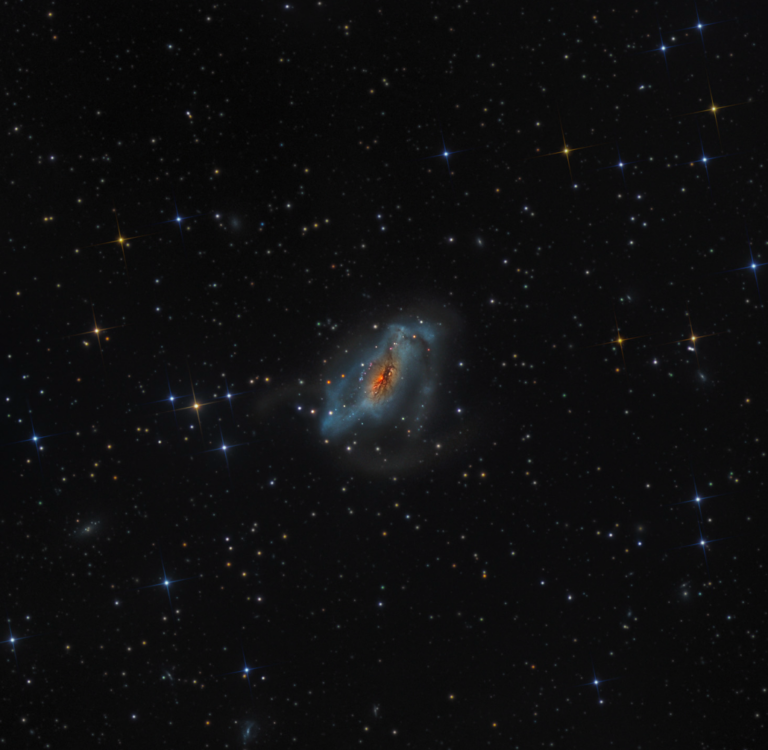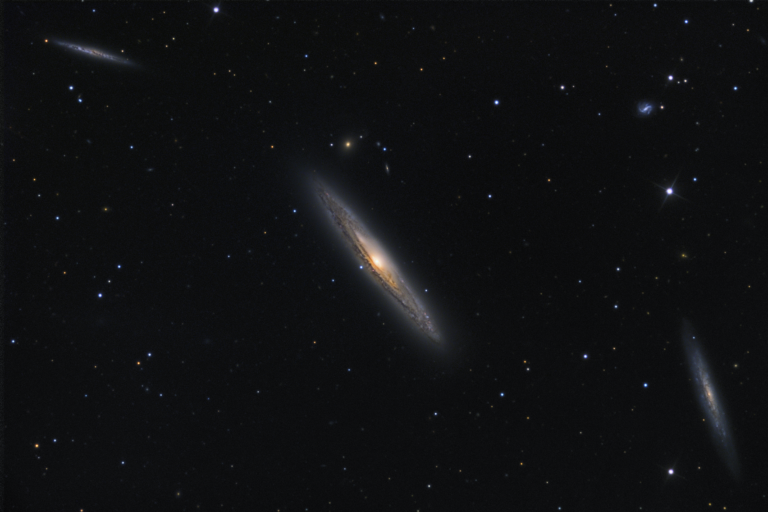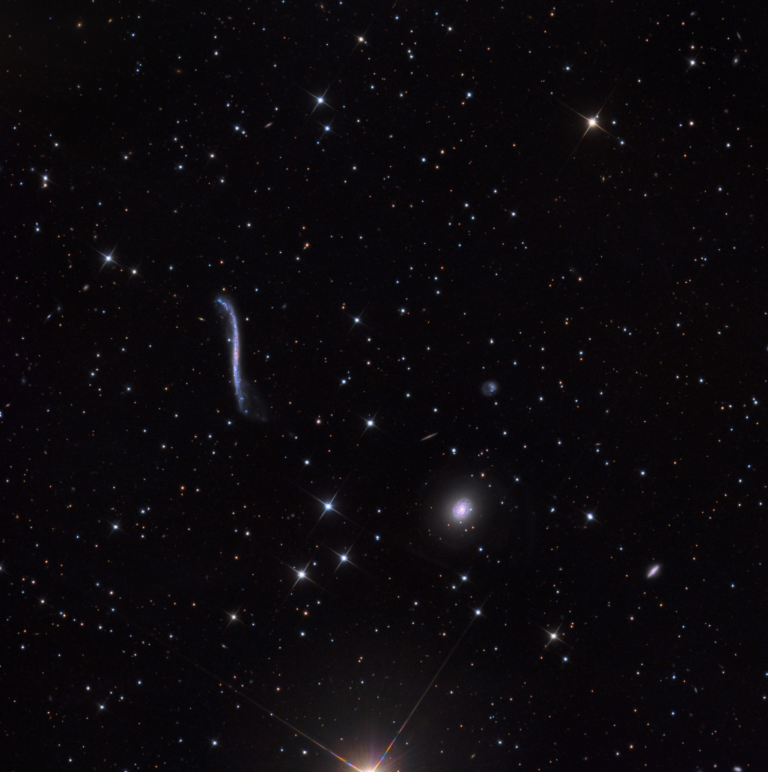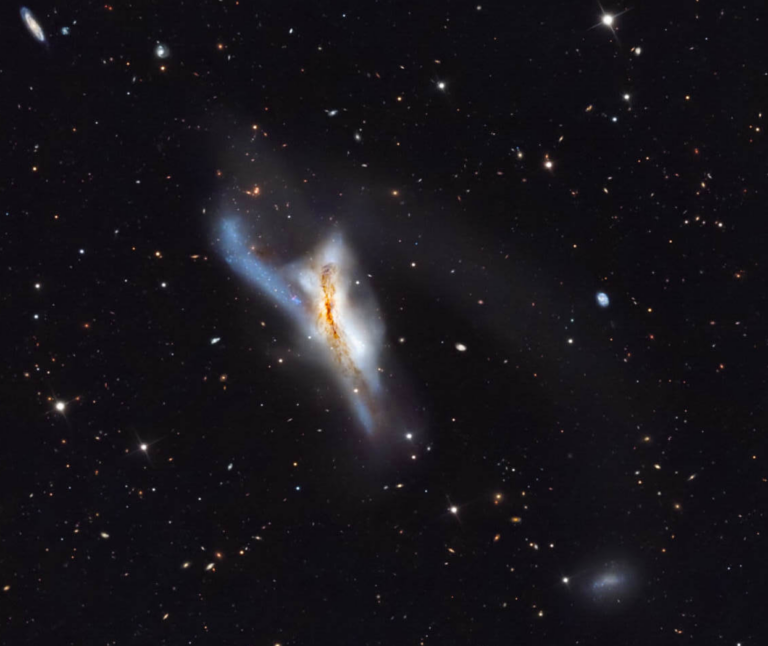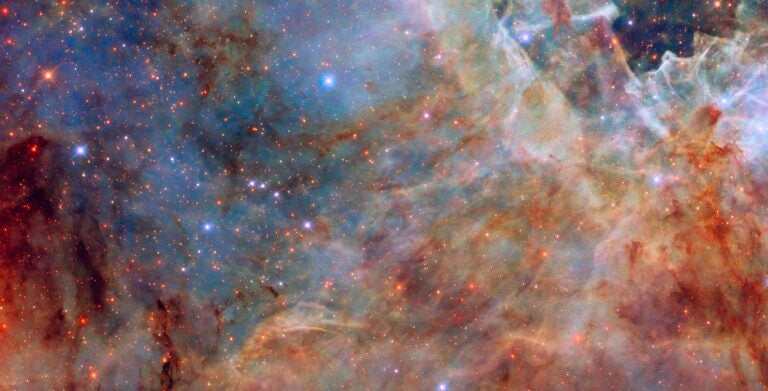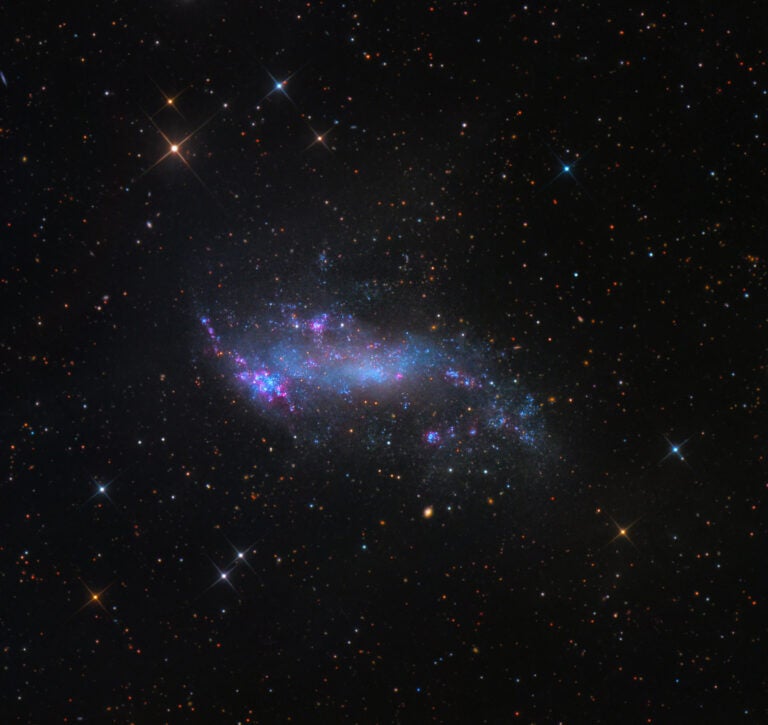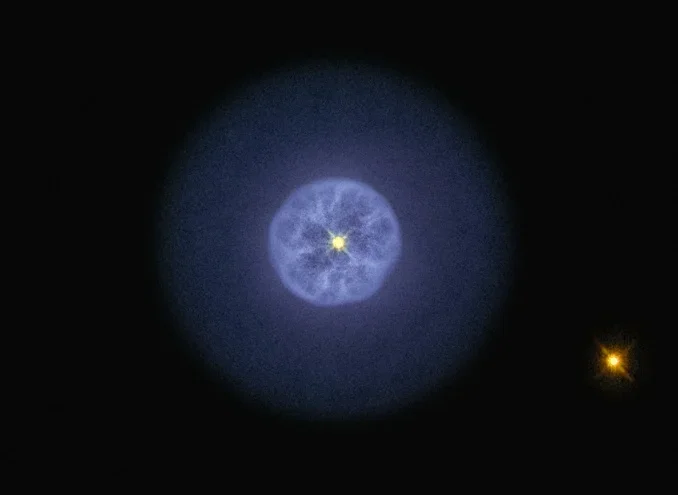Some 50 years before Napoleon’s troops found the Rosetta Stone buried in the ground, another French explorer made an equally stunning discovery not beneath their feet, but above their heads. In 1751, astronomer Nicolas-Louis de Lacaille was surveying the deep southern sky from the Cape of Good Hope through his 1/2-inch refractor when he stumbled upon a small nebula. The object resided near the northeastern edge of the Large Magellanic Cloud (LMC), the immense nebulous region that astronomers now recognize as a satellite galaxy to the Milky Way.
Lacaille cataloged it as a “Nebula of the first kind,” meaning he could not see any star in the nebula through his telescope. In his 1801 star atlas Uranographia, German astronomer Johann Bode referred to it as 30 Doradus, reflecting its position in the constellation Dorado the Dolphinfish. It wasn’t until the 20th century that deep photographic exposures taken through large-aperture scopes revealed the object’s spidery tendrils of glowing gas that inspired its common name: the Tarantula Nebula.
Big, bright, and beautiful
The Tarantula is a giant stellar nursery in the midst of transforming a massive reservoir of mostly hydrogen gas into hundreds of thousands of stars. The biggest of these newborn suns are among the most massive known, and they burn hot and bright, ionizing the surrounding gas and causing it to glow with a characteristic reddish color.
Although you can use words like big and bright to describe the Tarantula, they really don’t do it justice. The entire nebula spans roughly 1,000 light-years. For comparison, the Milky Way’s Orion Nebula (M42), the finest example of a star-forming region visible from mid-northern latitudes, is a mere 25 light-years in diameter. And the Tarantula shines brightly enough to see with the naked eye from the Southern Hemisphere, despite lying some 160,000 light-years from Earth. By contrast, naked-eye M42 is but a stone’s throw away at 1,500 light-years.
To put it another way, if you were to place the Tarantula at the same distance as the Orion Nebula, it would cover as much sky as 75 Full Moons placed side by side — enough to stretch 40 percent of the way from the horizon to the zenith. And it would be bright enough to cast noticeable shadows.
Even where it is, the Tarantula is still close to us in cosmic terms. And that makes it an enticing target for astronomers. “The Tarantula Nebula is the region of most intense star formation in the Local Group — a region within about 10 million light-years of the Sun that includes more than 80 galaxies,” says astronomer Elena Sabbi of the Space Telescope Science Institute in Baltimore. “[It’s] the only example of a starburst — an extremely intense and rapid episode of star formation — that we can study in detail.”
In fact, astronomers wouldn’t necessarily want the Tarantula to be any closer. Because it lies away from the dust-laden disk of the Milky Way, scientists have an unobscured view, allowing them to clearly see the objects within it. It’s more difficult to study nearby star-forming hot spots — like the Orion Nebula and the Carina Nebula (NGC 3372) — because astronomers must view them through the dusty haze of our galaxy’s disk.
“The Tarantula is close enough for us to study individual stars across the electromagnetic spectrum, from X-rays to infrared, as well as to consider it as a single nebula,” says Paul Crowther of the University of Sheffield in the U.K. You have to look much farther to see similarly impressive star-forming regions, he adds, so astronomers can’t resolve their individual stars and can study only their overall properties.
Untangling the Tarantula’s web
The Tarantula has enthralled astronomers ever since Lacaille first laid eyes on it 270 years ago. But the tools needed to decipher the nebula’s inner workings have a much shorter pedigree.
The Hubble Space Telescope has played a leading role in deciphering the Tarantula. Sabbi leads the Hubble Tarantula Treasury Project (HTTP), a multiwavelength survey that provides the most accurate census of the nebula’s stars. “HTTP is a high-resolution survey that consists of several filters from the near ultraviolet, [which is] sensitive to the light coming from the hottest and most massive stars, to the near infrared, [which] can penetrate thick walls of dust and reveal where low-mass young stars are still growing,” she says.
So far, the census includes 820,000 stars, ranging from monstrosities that tip the scales at more than 200 solar masses down to stars with just half the mass of the Sun. “Thanks to Hubble, we can study how high- and low-mass stars coexist, and if the powerful radiation coming from the massive stars modifies the normal evolution of their smaller companions,” Sabbi says.
Evans and three of his colleagues hatched the idea for the survey in late 2007. They were in Utrecht in the Netherlands, attending a meeting of researchers studying massive stars in the Milky Way and the Large and Small Magellanic Clouds using the Fibre Large Array Multi Element Spectrograph, or FLAMES. The instrument can target more than 100 objects at a time, splitting the light from each one into its own spectrum to reveal its physical properties.
Evans and his colleagues had been studying massive O-type stars, but they had precious few examples in their dataset. As they huddled at a local pub, a plan to enlist FLAMES began to take form.
“We came up with a working idea of: ‘Let’s try to do everything in the Tarantula,’ ” recalls Evans. “That would give us a sample size large enough to solve many of our problems.” They mapped out a rough idea for the survey in the following weeks and then assembled a proposal for time to use FLAMES on one of the 8.2-meter telescopes of the European Southern Observatory’s Very Large Telescope (VLT) array in Chile.
“FLAMES provides us with optical spectra of up to 130 objects simultaneously across a 25′ field of the sky,” says Evans. That’s enough to cover a large fraction of the Tarantula. “This means that instead of obtaining spectra of stars one by one in such a rich part of the sky, we can make much more efficient use of precious VLT time.” The observations yield the temperature, surface gravity, composition, rotation, and line-of-sight velocity of each star.
Into the spider’s lair
The Tarantula may seem like a monolithic entity, but the surveys have helped to show it has many interrelated parts, with several distinct star clusters and multiple regions of nebulosity. At the nebula’s heart lies the impressive star cluster Radcliffe 136 (R136). Until the 1980s, astronomers suspected that this intensely bright central region held a single supermassive star that weighed perhaps 1,000 Suns. That would be quite remarkable, not least because the laws of physics dictate that no such star could exist.
But as astronomers developed high-resolution imaging techniques and Hubble soared above Earth’s distorting atmosphere, R136’s true nature came into focus. It turns out to be a compact star cluster comprising dozens of O-type main-sequence stars — the hottest, brightest, and most massive stars that are still converting hydrogen into helium in their cores — and equally hot and massive Wolf-Rayet stars, which are characterized by ferocious stellar winds.
No other spot in the known universe contains as many of these stellar behemoths. “The Tarantula in general, and its dense star cluster R136 in particular, contain the most massive stars we have currently identified, with several dozen exceeding over 100 times the mass of our Sun,” says Crowther. “The most extreme likely started their lives with 200 to 300 solar masses, but they have already slimmed down by 10 to 20 percent in the last million years or so because they shed weight at an amazing rate.” The 10 brightest of these stars provide nearly 30 percent of the energy ionizing all of the Tarantula’s gas.
The more massive a star, the shorter its lifespan. O-type stars live no more than a couple of million years before they exhaust their nuclear fuel and ultimately detonate as supernovae or implode directly into black holes. The abundance of these heavyweights in R136 suggests it is no more than 1 million to 2 million years old. Sabbi’s team has also discovered a smaller, more diffuse clump of stars 15 to 20 light-years northeast of R136. This group has no O-type stars but does hold slightly smaller and cooler B-type stars, implying it is perhaps a million years older than its neighbor.
The density of stars in this region leads some scientists to speculate whether it might one day form a globular cluster. Although all of the globulars in the Milky Way are ancient, dating back to near the birth of our galaxy, the LMC holds many youthful lookalikes. The volume within about 65 light-years of R136 contains nearly 90,000 solar masses of material, close to the average size of Milky Way globulars.
Seeing first light
Surrounding R136 lies NGC 2070, the brightest region of nebulosity in the Tarantula. This is where the bulk of the remaining hydrogen gas resides, and where stars currently are forming at a furious rate.
The Tarantula’s environment isn’t quite so hectic beyond NGC 2070’s borders. The nebula apparently came to life 20 to 30 million years ago, when stars started to turn on some 145 light-years northwest of R136’s current location. This initial surge gave birth to the star cluster Hodge 301. Tens of millions of years is plenty of time for the most massive stars to explode, and astronomers estimate between 40 and 60 supernovae have gone off here during the cluster’s lifetime.
The explosions have had two distinct consequences. First, they have cleared out much of the gas and dust in Hodge 301, affording astronomers a reasonably crisp view of the cluster. Second, the expanding supernovae shock waves have compressed gas on the outskirts of NGC 2070, helping to jumpstart star formation there.
The Tarantula’s third major star cluster is NGC 2060. It lies about 290 light-years southwest of R136 and its stars formed roughly 4 million to 6 million years ago, placing it intermediate in age between R136 and Hodge 301. Although NGC 2060 looks rather dull compared to R136 and is not as well-defined as Hodge 301, it embraces some of the Tarantula’s most notable citizens.
The cluster likewise harbors the fastest rotating normal star, VFTS 102. The VLT-FLAMES survey found this star’s equatorial regions spinning at a rate of 1.4 million mph (2.2 million km/h), or some 300 times faster than the Sun. The rapid rotation means VFTS 102’s shape more closely resembles an M&M than a sphere.
These three regions tell only part of the Tarantula’s story. Massive stars are spread across the entire region, with some of them apparently flung from their birthplaces. VFTS 016, for example, is a massive runaway star located well to the northwest of NGC 2060. Discovered as a fast mover during the initial stages of the VLT-FLAMES survey, the team only managed to measure its line-of-sight velocity. Eight years later, the researchers used data from the European Space Agency’s Gaia spacecraft to pin down its speed: 225,000 mph (360,000 km/h)! Its position and motion indicate it was ejected from R136 about 1.5 million years ago and has since traversed 375 light-years. The scientists suspect the star once belonged to a binary system that suffered a rogue encounter with a third star, launching it on its epic journey.
Probe of the distant universe
Studying massive binary systems in the Tarantula was one of the motivating forces behind the VLT-FLAMES survey. The results are startling: “We estimate that at least 50 percent of our targets are in binary systems,” says Evans. “Alongside complementary studies in our own Milky Way, this result has significantly changed our perspective on stellar evolution.”
Close binaries can interact in many ways, he adds. Mass and angular momentum can be transferred from one star to the other, and eventually the two stars can merge. “This results in very different evolutionary paths than if [they were] born as single stars.” Some of these systems may develop into binary black holes and ultimately merge, producing a torrent of gravitational waves like those from similar systems that astronomers began detecting in 2015. Not surprisingly, the current record holder for a massive binary system, Melnick 34, resides in the Tarantula. Each of its two components weighs in at about 120 solar masses.
The biggest opportunity to arise from the HTTP has been to study the lifecycle of a starburst from up close. “The Tarantula Nebula has been forming stars for the past 30 million years,” says Sabbi. “The epicenter of star formation during this time has moved considerably, and we can see how powerful stellar winds and violent supernova explosions have shut down star formation in one region of the Tarantula, just to start it again a few hundred light-years away.”
What has happened just recently in the Tarantula may be a window into the universe’s early history. Casting their gaze outward, astronomers detect what seem to be similar starbursts in galaxies so distant that universal expansion has shifted their light far toward the red end of the spectrum. “The Tarantula’s properties appear to be comparable to knots of intense star formation in young galaxies at high redshift, so it gives us a local clue to galaxy assembly in the early universe,” says Crowther.
Using the Tarantula as a model for these systems offers one more advantage over any potential Milky Way counterparts: The Tarantula and the surrounding LMC have far fewer heavy elements than star-forming regions in our own galaxy. The amount of metals — astro-speak for elements heavier than helium that stars have cooked up over the eons — in the LMC is only half that of the Milky Way, making it much more similar to the more pristine material present in the distant, early cosmos. With the Tarantula, it’s almost as if astronomers have stumbled on their own Rosetta Stone, and have started using it as a key to understanding the mysteries of star and galaxy formation.
Scientists have been fortunate to have front-row seats to the Tarantula’s display. “We’re lucky to be witnessing these fireworks when the Large Magellanic Cloud is on its closest approach to the Milky Way in the last billion years or so,” says Crowther. Alas, the performance may not run that much longer. “Much of the gas from the original molecular cloud has now turned into stars, so we expect the rate of star formation to decline in the next few million years.”
When the show eventually ends, every astronomer in the house will say it had a great run.

